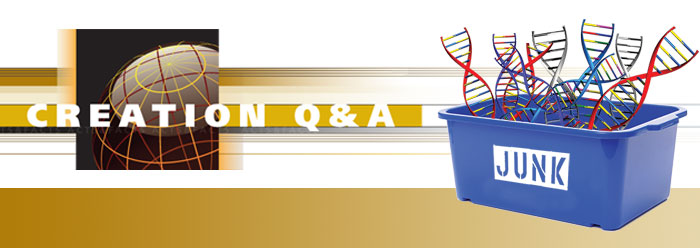The theistic evolutionary organization BioLogos recently and publicly challenged creationists to explain specific examples of “junk DNA.”1 This “gauntlet” provides a unique opportunity to recognize and understand some of the evolutionists’ tactics.
The claim of junk DNA is not new. The founder of BioLogos, Francis Collins, made the argument in 2006 in his book The Language of God that “roughly 45 percent of the human genome is made up of…genetic flotsam and jetsam….This kind of recent genome data thus presents an overwhelming challenge to [creationism]….Of course, some might argue that these are actually functional elements placed there by a Creator for good reason, and our discounting them as ‘junk DNA’ just betrays our current level of ignorance. But certain examples severely strain the credulity of that explanation.”2
What examples? Two were recently offered by Dennis Venema, one of the regular bloggers for BioLogos. He cited the existence of the vitellogenin “pseudogene” and the presence of large amounts of repetitive sequence in the DNA of the onion as difficult to square with special creation.1
Have the evolutionists found a hole in the biblical model?
Both Collins’ and Venema’s claims miss the larger picture. While Collins acknowledged ignorance as a possible (albeit unlikely) explanation for the existence of junk DNA, he didn’t grasp the depth of the chasm in our knowledge. Neither did Venema. Since Venema put the burden of proof for “function” on creationists, he implied that the evidence for non-function was substantial—or “overwhelming,” to borrow Collins’ expression. In fact, the opposite is true.
To conclude that a DNA sequence has no function (i.e., that it is “flotsam and jetsam” or “junk”), a scientist must have tested every base pair (the four DNA base pairs are A,T, G, and C) in the human genome (the totality of our DNA sequence) for function. This is an impossible task.
Simple math demonstrates why. The human genome is about 3,000,000,000 DNA base pairs long. This long stretch of molecular code is responsible for the development—initially over a period of nine months and then decades in totality—of the trillions of the adult cells that make up the human body. Clearly, it is impossible for any scientist or even a worldwide consortium of scientists to have tested, one by one, all of these DNA base pairs in all of these cells at all of these points in time.
Thus, the burden of proof for the assertion of “non-function” actually rests on those proposing this hypothesis. When Venema cited two isolated examples of supposed non-function, he didn’t discover a problem for the creation model; he found two new hypotheses to test. He argued from assumption, not from evidence—an argument no one should take seriously.
Will more experiments confirm the BioLogos assumption? The track record of research on “junk” DNA suggests otherwise. Just 12 years after the initial publication of the human genome, scientists have discovered preliminary evidence for function for 80 percent of the genome.3 Despite falling woefully short of testing every base in every cell at every point in time, this study is the most comprehensive to date. More experiments such as this will likely hurt the BioLogos position, not help it.
Venema is aware of these results. In fact, his public challenge to creationists was in response to these data. Yet, instead of acknowledging the premature nature of the junk DNA assertion, Venema responded by refining his definition of “function” and then challenging creationists to experimentally prove “function” for the two “non-functional” examples. These sorts of rhetorical devices are common in the origins debate and on the BioLogos website. No believer should be intimidated by them.
Genetic evidence continues to confirm the biblical account. “Junk DNA” does not exist—except in the mind of the savvy evolutionary debater.
References
- Venema, D. ENCODE and “Junk DNA,” Part 2: Function: What’s in a Word? The BioLogos Forum. Posted on biologos.org September 26, 2012, accessed February 12, 2013.
- Collins, F. S. 2006. The Language of God. New York: Free Press, 136-137.
- The ENCODE Project Consortium. 2012. An Integrated Encyclopedia of DNA Elements in the Human Genome. Nature. 489 (7414): 57-74.
* Dr. Jeanson is Deputy Director for Life Sciences Research and received his Ph.D. in Cell and Developmental Biology from Harvard University.
Cite this article: Jeanson, N. 2013. Does “Junk DNA” Exist? Acts & Facts. 42 (4): 20.




